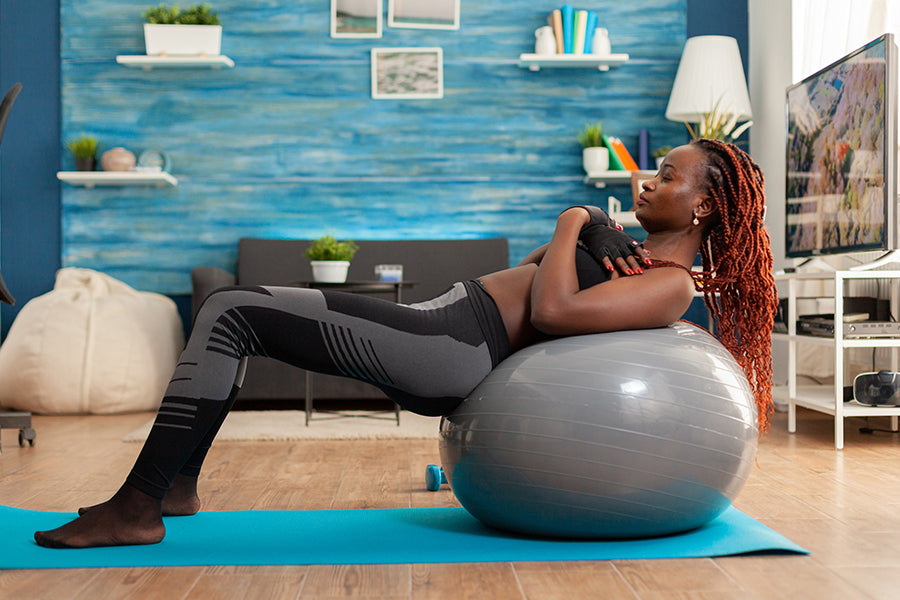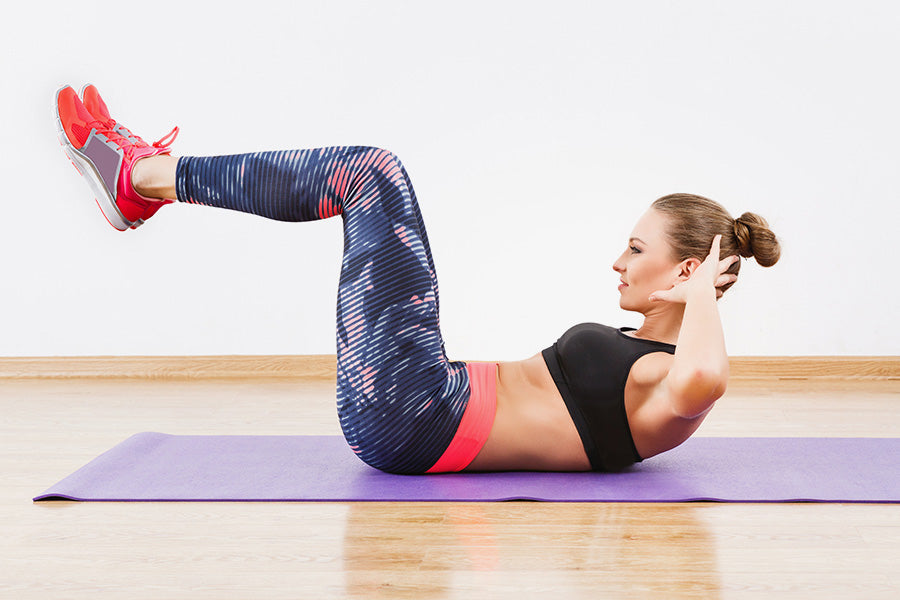Reverse crunches are an effective and simple exercise to strengthen your core muscles. This exercise can help improve your mobility, balance, and posture.
Incorporating reverse crunches into a full body workout routine such as Pilates or resistance training can help build strength and promote fat loss. This article discusses the benefits and types of reverse crunches you can perform and highlights the mistakes to avoid.
Related Article: The Top 10 Ab Exercises to Get a Killer Six-Pack
What Does the Reverse Crunch Do for Your Body?
The reverse crunch is an effective exercise for targeting the lower abdominal muscles. It engages the rectus abdominis, transverse abdominis, and obliques to improve core strength and stability. When performed correctly, reverse crunches can help you build a strong and toned stomach area with improved posture.
Reverse crunches provide other bodily benefits, such as increased flexibility and balance, improved coordination, and better circulation. Regular practice of reverse crunches can therefore lead to long-term health improvements.
You can enjoy these benefits by incorporating reverse crunches into your regular fitness routine while achieving a more sculpted midsection. Ultimately, reverse crunches are an excellent exercise for improving the health and physique of your body. Practice proper form when doing reverse crunches to ensure maximum benefit from this effective exercise.
Here’s how to perform a reverse crunch:
- To begin, lie on your back on an ab mat with your feet flat on the ground, knees bent at 90 degrees, and arms by your sides.
- Flex your abs as you bring your knees up toward your chest while simultaneously lifting both shoulders off the ground in a reverse crunch motion.
- Keep your lower back close to the floor throughout this maneuver.
- Hold for a few seconds at the top of the reverse crunch, then lower your upper body and legs back to the starting position.
What are the Benefits of Reverse Crunch?
The reverse crunch exercise provides you with the following benefits:
Strengthens & Tone the Abdominal Muscles
The reverse crunch is an incredibly effective exercise to add to your core workout routine. Not only does it engage the core, but it can also help strengthen and tone abdominal muscles as well.
Working out these muscle groups can improve overall balance, posture, and stability. If you’re looking for an exercise to build up your core strength and target all major abdominal muscles, reverse crunches should be part of your routine. The movement is simple but yields significant results, so get ready for a more toned midsection!
Helps Improve Posture & Reduce Back Pain
Reverse crunches can be a valuable exercise for anyone looking to improve their posture, reduce back pain, and increase their overall body stability. By working core muscles in the lower abs, this exercise strengthens the deep trunk muscles that make up your core.
With improved core strength, you will have better stability during everyday movements when standing, bending, turning, or carrying items. Additionally, stronger core muscles can help correct poor posture and reduce lower back pain by reducing pressure on your spine.
Tones Your Abs and Obliques
Regular reverse crunches are one of the best exercises for toning and defining your abs and oblique muscles. Reverse crunches force the abdominals to contract against resistance, so they respond and get stronger. The focus on the abdominal region also makes them an excellent exercise to target the oblique muscles, giving the body the coveted V shape look everyone wants!
You can easily adjust the intensity of reverse crunches by changing how high you lift your legs; your core muscles will work harder by lifting higher off the ground!
Offer Long-Term Benefits
Reverse crunches are an excellent exercise for anyone looking to start or refine their fitness plan. When done correctly, reverse crunches can be beneficial in improving the strength of your lower back and core muscles, giving you the stability needed to perform other, more complex exercises.
Additionally, with regular practice, reverse crunches can aid in strengthening the abdominal musculature and decreasing inflammation in the lower back region. Not only that, but they are relatively low-impact exercises that can be performed without any equipment required to get a good workout.
By making them a consistent part of your routine, you can reap the rewards and benefits such as enhanced flexibility, improved posture and an overall stronger physique—all with minimal risk of injury and maximum efficiency!
Modifications and Variations
Variations on reverse crunches can be done with added weights in your hands or by adding a twist at the top of the reverse crunch motion.
Reverse crunches are a great core exercise to target the lower abdominal muscles and can be modified or varied to challenge your strength and stability. Here are some reverse crunch alternatives you can try and learn to do a reverse crunch with a twist.
Bicycle Crunch

This bicycle crunch is a fantastic workout for engaging the oblique muscles and supporting trunk rotation and the abs.
- Lie on your back with one knee stretched straight ahead and the second tucked against your chest while putting your hands behind your head and bringing your opposing elbow over your front knees; switch the positions of the feet.
- Start with one set and work your way up as the activity gets easier, increasing the amount of reps & sets.
- Perform at least 5 - 10 repetitions on every side while swapping positions.
Oblique Crunch

Another reverse crunch variation that targets the obliques is the oblique crunch.
- Position yourself on your side.
- The left hand should be behind the head, while the right hand should be around your side.
- Bend the trunk laterally, contracting your oblique.
- After pausing briefly at the movement's peak, carefully resume your starting posture.
- Do at least 10 reps on each side.
Stability Ball Crunch

The stability ball crunch is a great way to work your core muscles and improve core strength. This exercise can be used in any fitness routine and modified to challenge your core even more.
- To perform stability ball crunches, start lying on your back with a stability ball directly under the middle of your shoulder blades.
- Your feet should be flat on the ground and hip-width apart.
- The stability ball should remain in place while you crunch up.
- Engage your core muscle to stabilize your spine as you slowly raise your torso towards the stability ball.
- Hold for a few seconds, then lower yourself back to the ground with control.
- Repeat this motion 10-15 times, depending on your fitness level.
- Rest briefly before starting another set of stability ball crunches when you finish one set.
- With practice and dedication, stability ball crunches can help improve your core stability and strength.
Butterfly Reverse Crunch

The butterfly reverse crunches are an effective core exercise that engages the abdominal muscles, hip flexors, and obliques. It requires modification of a traditional reverse crunch, isolating the lower abs.
It can be executed as an isolated move or used with other core exercises to add variety and challenge your muscles.
- To perform the butterfly reverse crunch, begin by lying on your back with your feet together and arms at your sides.
- Engage the core muscles and slowly lift your legs off the ground while bringing your knees towards the chest.
- Then, using a scissor-like motion, open your legs into a V-shape while keeping your knees bent and hovering just off the ground.
- Reverse the motion, returning to the starting position.
- Aim for 8-15 repetitions depending on your fitness level.
Some Common Mistakes to Avoid
Common mistakes when doing reverse crunches include the following:
Using Momentum
The first mistake people make when doing reverse crunches is using momentum instead of controlling the movement with their abdominals.
This often happens when people move too quickly and let gravity take over, which can cause strain in the lower back. To avoid this, focus on using only your core muscles throughout the full range of motion.
Flexing Neck Forward:
Another common reverse crunch mistake is flexing the neck forward as you curl up. Instead, keep your chin slightly tucked and maintain a neutral spine posture throughout the movement. This will ensure that you engage your abdominals instead of your neck muscles.
Not Extending Legs Properly
Finally, the reverse crunch technique can be flawed when people do not extend their legs back to a straight position after curling them up. For reverse crunches to be most effective, make sure to fully extend your legs before beginning the next rep so that you engage both your lower and upper abdominal muscles.
To perform reverse crunches correctly and avoid injury, it is essential to remember these common mistakes while exercising. Stay mindful of using only your core muscles, maintaining proper posture, and extending your legs between each rep. Doing so will help you get the most out of reverse crunches and maximize your results.
The Bottom Line
The reverse crunch is a great way to tone your abdominal muscles. It can be done with or without added weights depending on the desired intensity of the exercise. However, proper form is essential. Doing reverse crunches incorrectly may lead to overstretching of the hamstrings and back, so take care when doing them.
With consistency and dedication, reverse crunches can help you reach your goals of toning, strengthening, and even losing weight. So get started with reverse crunches today!
Reading List
Article Sources
- Koh, Hyung-Woo, et al. “Comparison of the Effects of Hollowing and Bracing Exercises on Cross-Sectional Areas of Abdominal Muscles in Middle-Aged Women.” Journal of Physical Therapy Science, vol. 26, no. 2, 2014, pp. 295–99. J-Stage, https://doi.org/10.1589/jpts.26.295.











